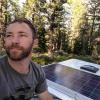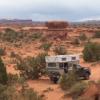FWC Lithium Manifesto
Ok, lately especially, my inbox has exploded with questions about DIY installation of lithium batteries into Four Wheel Campers. We’re talking 5 new inquiries a day. There is a lot of info about it on here already, but I thought maybe it would be helpful if I put it all into one, centrally located place from a more or less reliable source..
This is going to be long, but I think I’ll cover everything you could ever want or need to know about the charging system in your four wheel camper, and how it relates to lithium batteries.
First: Why lithium over AGM?
Well, honestly, it depends.
- Full depth of discharge. You can only really pull 40-50% of the rated amp hours from lead batteries and expect them to live more than a year or so. Lithium batteries are rated for 100% Depth of discharge. This means that a dual 6v setup of AGM batteries is rated for about 224ah. BUT, you can only use just under half of that which makes them effectively 110ah of usable power when they’re new. A SINGLE 100ah Battleborn will have the same effective capacity as two 6v GC2 AGM’s and more capacity than the 2x 12v AGM batteries commonly installed into FWC. IF YOU CURRENTLY HAVE 2x AGM BATTERIES… YOU’LL ONLY NEED A SINGLE 100AH LITHIUM TO MATCH OR EXCEED THEIR CAPACITY
- Weight and space savings. As stated above, you need FEWER batteries to make the same power from lithium when compared to lead options. Not only do you need fewer, but the lithium batteries are MUCH lighter. A single battleborn 100ah weighs about 27lbs. A set of GC2 AGMs weighs about 120lbs. For some rigs, the weight savings of 90lbs isn’t a big deal. For some, it is.. *cough* tacomas *cough*
- Life span. Like I said before, you can expect your AGM batteries to last about 5 years.. IF you take good care of them. If you aren’t one to babysit your voltage and keep track of your energy use/charging, you’re looking at more like 1-2years between sets. At $600 for a set of GC2 6v batteries, that’s not cheap. A good lithium battery is warrantied to last 10. I’d expect them to actually last much longer in low-draw use like most of us have in our campers. Yes, the batteries are $800, but it doesn’t take many replacements to make up for the cost difference.
- Yes.. they also can be charged/discharged faster. Whoopee. In the context of a FWC system, again with low draw, and low-ish rate charge sources, this isn’t much of a benefit really, but it does exist in theory.
- But what about cold!?!?!?! A battleborn, as well as most other quality lithium batteries with internal BMS units will not charge below 27 deg F or so. Charging below that temperature WILL damage them, but, the BMS prevents this. So, if your battery is below 27deg internal temp.. it will simply not charge until internal temperature increases. IT WILL DISCHARGE, meaning your lights, pump, and HEATER will still work just fine. Which brings me to another point on this. FWC batteries are installed INSIDE. I use my camper all year long, including for ski and snowshoe trips. I run the heater. That’s WHY I have a camper. When I’m actively using the unit, it is NEVER below 27 deg inside. I also leave water in it all year round. If you are a sadist and like being super damn cold in your camper, there are many options for both internally heated batteries, as well as heating pads to warm them to a reasonable temperature and allow charging.
If you aren’t weight conscious and are a conservative power user who doesn’t mind keeping an eye on voltage.. honestly, your 2x 6v batteries are probably fine. If they’re working for you, keep on keeping on. Definitely don’t swap out a good set of batteries just because. Tacoma people: Swap out the 6v for a single lithium and you can bring either: 1x large dog, or a multitude of smaller dogs. Or several more cases of beer. Whatever you prefer.
Now for the real meat and potatoes. Charging.
First.. most lithium batteries on the market like an absorption charge of 14.4-14.6v or so to get to 100% full. If your charger isn’t capable of putting out voltage that high, it will not charge the batteries all the way.
Your FWC (and MOST vans/trucks/adventuremobiles) have two to three charging sources. The sources are:
Shore power, engine power (alternator), Solar. We’ll take each one in turn.
- Shore Power- When you’re plugged into an external AC source, like at a campground or an outlet into your garage, the IOTA AC to DC battery charger inside your camper takes the 110v alternating current and turns it into 12v DC power, then sends it to your batteries to provide a charge. Older IOTA chargers have an option to plug in an external module to adjust it’s parameters to better charge lithium batteries, newer ones do not. In my experience, the IOTA charger is typically not able to charge a battleborn battery more than 80-90%. Will this hurt the battery? Well, technically, yes. If used this way long term with no other charging sources, you could see a drop in battery life since it’s not being fully cycled. So, technically YES, but effectively.. NO. Almost NO FWC users plug in on a regular basis. Even if you do plug in regularly, you also more than likely have a second or third charge source that IS capable of charging the battery fully, so the IOTA really becomes a non-issue. So maybe it can only charge 80%. No big deal, solar or the alternator (through a DCDC charger) can take care of the rest, and realistically will be your main charge sources anyway.
- Engine Power- The factory setup from FWC is through 10awg wire a 30 amp self-resetting circuit breaker, and an Atwood trolling motor plug. The 10awg wire is connected to the starting battery under the hood, and connected to the house, or camper, battery through those components. You wouldn’t want your fancy Isotherm fridge or your furnace to drain the truck battery and prevent you from staring the engine in the morning, however, so the two batteries are ‘isolated’ by a Blue Sea ACR (automatic charge relay) or a similarly functioning SurePower charge relay in older models. These work by connecting the two systems together through a large internal switch when the relay senses a higher than expected resting voltage, indicating the truck is running. When the truck is turned off, the voltage drops, and the relay disconnects, effectively isolating the two battery systems from each other and protecting the truck from excessive discharge (from the camper, leave your headlights on and she still ain’t gonna start). Now, most alternators never put out a high enough voltage to completely charge ANY deep cycle battery, lead acid or lithium. Typically, this isn’t a problem assuming you have solar to supplement. What IS a problem, is the tiny 10awg wire between the two batteries. It’s simply not large enough to carry the current that either a single lithium OR a dual 12v/dual 6v bank would really like. We typically only see 6-9 DC amps of charging through the factory setup. Imagine trying to suck a chunk of strawberry through your milkshake straw. Simply upgrading the wire and retaining the Blue Sea ACR, even with dual 6v systems, we see 25-45 amps of charging. That’s a huge difference and makes for huge drops in driving time to full (or almost full) charge.
So, small wire bad. Not enough amps for effective charging. Doesn’t matter what type of battery you currently have. Another issue, for lithium, is that the factory ACR won’t disconnect the battery banks when the engine is off, since the lithium battery will rest at a higher average voltage than the original AGM batteries. At first this seems bad.. like it’ll keep them connected and allow the house system to drain the truck batteries, but nope. Once the house system, even the lithium batteries, are low-ish the ACR WILL disconnect and isolate the two, saving you from an early morning no-start.
There is another issue, however. Many newer vehicles have “smart” alternators. The higher resting voltage of the lithium can also play havoc with these fancy new alts. My 2017 GMC, for example, when connected directly to the lithium bank in my Grandby, would detect the higher voltage and assume the truck battery was perfectly charged, effectively shutting down the alternator. I would have periods where the power would actually run BACKWARDS. I would see a large draw out of my camper battery, going TO the truck. My house battery was essentially powering my GMCs systems, fuel injection, ignition, etc. Not really ideal.
We’ve identified three issues with the factory truck-camper system and a fancy new lithium battery: ineffective charging rate, inability to charge fully, AND weird undesirable issues with smart alternators. Another aside here: people will tell you that the lithium battery will accept TOO MUCH charge and will fry your alternator. This is technically true, but a standard single battery will never really draw enough over a long enough period of time to have that be an issue. Regardless, the solution to the preceding three issues will also eliminate concerns of alternator-killing overdraw.
DCDC Charger! A DCDC charger takes the voltage from the truck and turns it into the voltage/amperage it thinks the camper battery will need, a good one is programmable and can be setup to perfectly charge whatever battery you’ve got, including your new lithium. It’s also a CHARGER, not a relay, so it will only charge the battery at it’s rated capacity, for the Victron we use, that’s 30 amps. It won’t ever pull too much power from your truck’s alternator, it’ll always charge the camper battery to 100% (given enough runtime, about 3hrs from empty for a 100ah battery) AND it completely separates the systems so you’ll never find the camper battery has drained your truck battery overnight (or ever).
And the final piece of the puzzle: SOLAR! The overland solar setup is more than capable of charging your new lithium battery without issues, assuming you reprogram it for the 14.4v absorption charge. Yep, that’s it. Nothing else. Just push some buttons and go camping. No wire upgrades, no extra panels, nothing. You CAN chuck more panels (or a larger panel) up there, but that’s just to increase charge capacity. It really has nothing to do, specifically, with the lithium battery itself. An extra, or larger, panel would also help out your dual 6v. As an aside, the 160w panel is just barely adequate to keep up with the isotherm. We won’t even bother to install anything smaller than a 210w panel.
Battery Monitor: There is one final piece of the puzzle though: Keeping track of that new battery and it’s state of charge. Honestly, monitoring an AGM with a voltmeter is pretty darn effective. Keep it above 12.2v and it will last a good long time. Lithium though, doesn’t have a linear voltage drop profile, so simply monitoring voltage isn’t a great way to discern state of charge or ‘SOC’. A battery monitor with a true negative line shunt is the way to do that. It’ll effectively count amps in and amps out, and let you know exactly how much battery you have remaining, all rolled into a nice percentage readout. It’ll also let you know exactly how much power you’re using in the moment (and historically) and how well your chargers are working. We require them in any install we do, simply because they ask so many questions and really help shine a light on what’s going on with a power system.
In conclusion. What do I need to do to use a lithium battery in my FWC? Well, really, nothing. You CAN just chuck one in there. If you have the newer MPPT (overland solar) controller, you’ll probably even be able to fully charge it a lot of the time.
If you really want to get the most out of your investment though, you should definitely install at the very least, a battery monitor.
After that, a DCDC charger. While you’re at it with the DCDC though, please upgrade that tiny wiring from the alternator back to the camper. Otherwise you’ll never get the full use of the DCDC. You’ll be limited to about 15-20% of it’s capacity.
Do you NEED lithium? Probably not. But it is pretty rad.


















